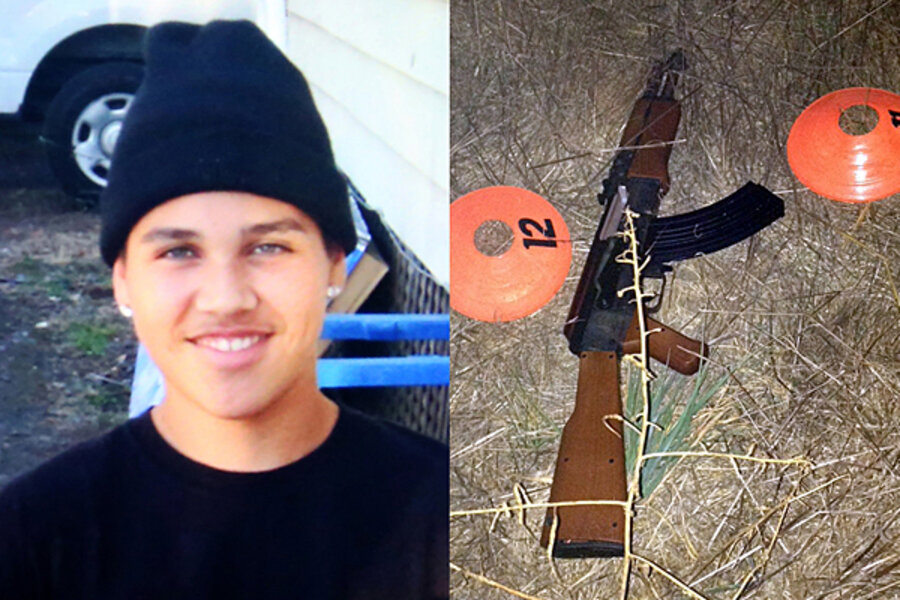Cop kills California boy toting toy rifle; a gun-anxious nation pauses
Loading...
An average American boy was shot and killed by police in northern California's wine country this week after sheriff’s deputies say they mistook 13-year-old Andy Lopez for a grown man about to open fire with an assault rifle.
Witnesses say the deputies in Santa Rosa, Calif., twice called for Andy to “drop the gun,” before the boy turned toward the squad car, which had its lights on and had let out at least one siren chirp.
One officer, apparently perceiving that the tip of the gun was being raised in his direction as Andy turned, opened fire. Given that the entire encounter took place in the span of 10 seconds, Andy’s friends and family are raising questions about whether overly jumpy police officers acted too rashly. Police say officers could not distinguish a toy gun that shot plastic pellets from a real one at the 30-foot range, and reacted in line with training.
The police shooting – the seventh in the US so far in October – happened on Tuesday in a field near Andy’s home. He was walking to a friend’s house to return the realistic-looking toy gun, which had had its orange safety tip removed. He was shot seven times, according to the coroner. The boy had another toy gun jammed in his belt, police say.
Police officers have mistaken toy guns for real in the past, which is partly why toy manufacturers are now required to mark toy guns with orange rifle plugs.
Nevertheless, the shooting and reaction to it, sociologists say, probe the potentially deadly mixture of police training and innocent toy play – a dynamic made only more poignant against a backdrop of news about mass shootings and public gun violence and a US culture that is increasingly tolerant of public-carry of weapons by adults.
At the least, the incident is giving parents pause about whether to let children play with toy guns on the street. It challenges the police community, too, to daily parse potential threats to themselves and the broader public.
“I think [Andy’s death] is a deeply resonant case because it reminds us, not unlike the George Zimmerman case [in the Trayvon Martin shooting], that so much of the ramifications of having an ‘armed society’ is predicated on how ‘threat’ is socially defined,” says Jennifer Carlson, a sociologist at the University of Toronto and an expert on US gun culture, in an e-mail. The problem is that “what defines ‘violent threat’ varies widely in different social contexts … [meaning that] you have a recipe for potentially lethal misunderstandings,” she says.
According to Sonoma County police officials investigating the shooting, the two officers – one a veteran, one a rookie – spotted a person on Tuesday afternoon wearing a hoodie and holding what appeared to be an assault rifle in his left hand. They stopped the squad car and took cover behind its doors, police said.
The officers told investigators that the person appeared to raise the barrel toward the officers as he turned around. Only after approaching the body did the officers realize the truth – that it wasn’t a threatening gunman but a boy with a toy rifle.
"The deputy's mind-set was that he was fearful that he was going to be shot," said Santa Rosa police Lt. Paul Henry.
National reaction has ranged from sympathy for the police officers to tough questions about whether the officer fired before properly ascertaining the threat. In the community of Santa Rosa, hundreds of people marched on Wednesday night, chanting, “We need justice.” Both officers, according to protocol, have been put on paid administrative leave pending an internal investigation into the shooting.
The shooting of Andy Lopez comes just over a month after a police officer in North Carolina was charged with manslaughter for shooting and killing an unarmed man trying to get help after a severe car accident. Another police shooting in Washington, D.C., on Oct. 3, of a mother who tried to drive her car through two security barricades and who later was said to be suffering from a severe case of postpartum depression, has also raised questions about officers' shoot-to-kill response to a perceived threat.






